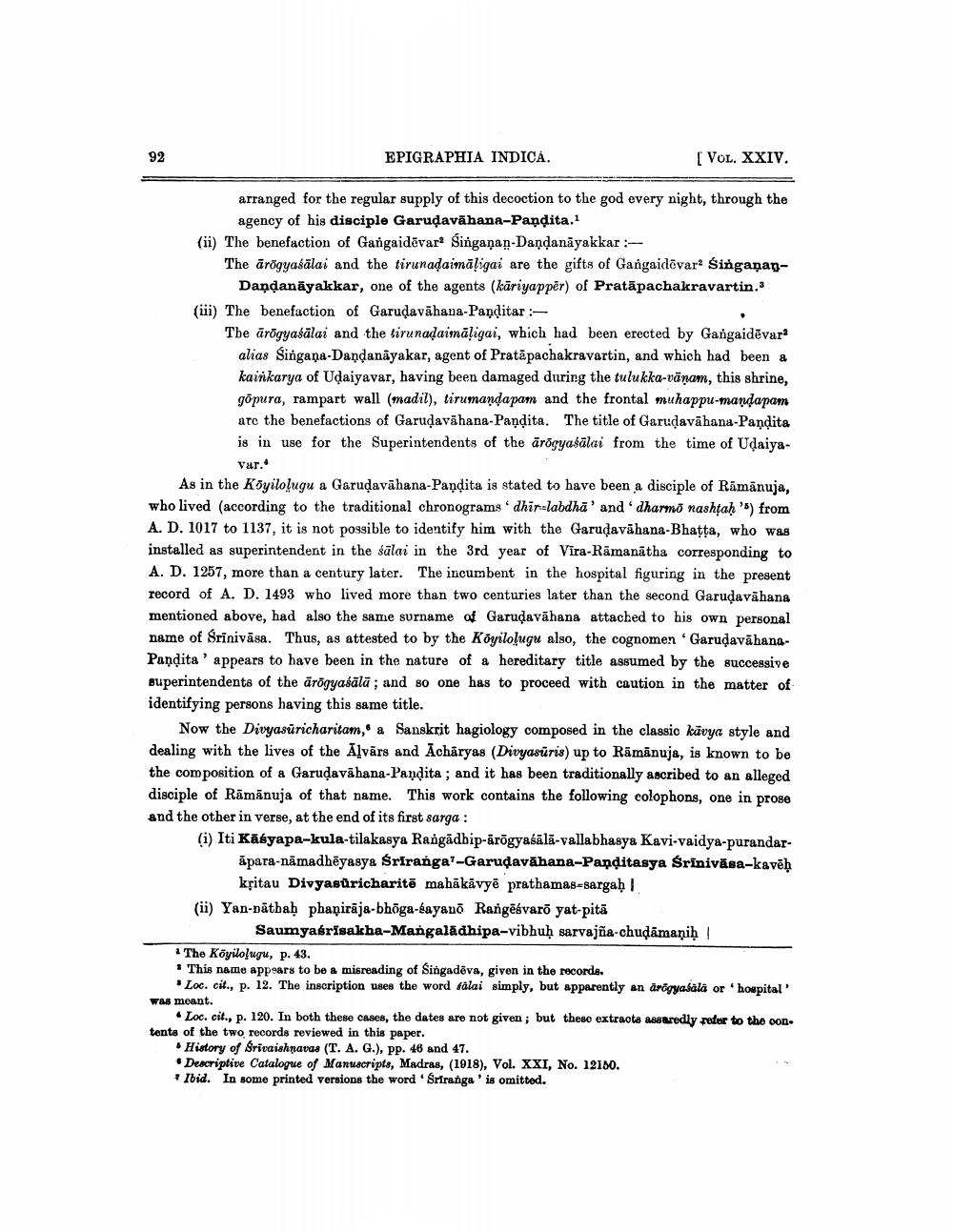________________
92
EPIGRAPHIA INDICA.
[VOL. XXIV.
arranged for the regular supply of this decoction to the god every night, through the agency of his disciple Garudavahana-Pandita.1
(ii) The benefaction of Gangaidevar Singanan-Dandanāyakkar :
The ārōgyaśālai and the tirunaḍaimāligai are the gifts of Gangaidevar SingaṇanDaṇḍanayakkar, one of the agents (kāriyapper) of Pratāpachakravartin.3
(iii) The benefaction of Garudavahana-Paṇḍitar :
The arōgyaśālai and the sirunaḍaimāligai, which had been erected by Gangaidēvar2 alias Singana-Dandanayakar, agent of Pratapachakravartin, and which had been a kainkarya of Uḍaiyavar, having been damaged during the tulukka-vānam, this shrine, gopura, rampart wall (madil), tirumandapam and the frontal muhappu-mandapam are the benefactions of Garuḍavahana-Pandita. The title of Garuḍavahana-Pandita is in use for the Superintendents of the ārōgyaśālai from the time of Uḍaiyavar.4
As in the Köyilolugu a Garuḍavahana-Pandita is stated to have been a disciple of Rāmānuja, who lived (according to the traditional chronograms dhir-labdhā' and ' dharmō nashṭaḥ '5) from A. D. 1017 to 1137, it is not possible to identify him with the Garuḍavahana-Bhaṭṭa, who was installed as superintendent in the salai in the 3rd year of Vira-Ramanatha corresponding to A. D. 1257, more than a century later. The incumbent in the hospital figuring in the present record of A. D. 1493 who lived more than two centuries later than the second Garuḍavāhana mentioned above, had also the same surname of Garudavahana attached to his own personal name of Srinivasa. Thus, as attested to by the Köyilolugu also, the cognomen GaruḍavāhanaPandita appears to have been in the nature of a hereditary title assumed by the successive superintendents of the ārōgyaśālā; and so one has to proceed with caution in the matter of identifying persons having this same title.
Now the Divyasüricharitam, a Sanskrit hagiology composed in the classic kavya style and dealing with the lives of the Alvars and Acharyas (Divyasūris) up to Rāmānuja, is known to be the composition of a Garudavahana-Pandita; and it has been traditionally ascribed to an alleged disciple of Ramanuja of that name. This work contains the following colophons, one in prose and the other in verse, at the end of its first sarga:
(i) Iti Kasyapa-kula-tilakasya Radgädhip-ürügyakälä-vallabhasya Kavi-vaidya-purandarapara-namadheyasya Sriranga1-Garuḍavāhana-Panditasya Śrīnivāsa-kavēḥ kritau Divyasüricharitē mahakavyē prathamas-sargah |
(i) Yan-nathab phaqirāja-bhiga-kayano Rangiévar yat pitä
Saumyasrisakha-Mangalädhipa-vibhuḥ sarvajña-chudamaniḥ |
The Kōyilolugu, p. 43.
This name appears to be a misreading of Singadeva, given in the records.
Loc. cit., p. 12. The inscription uses the word salai simply, but apparently an arogyasälä or 'hospital'
was meant.
Loc. cit., p. 120. In both these cases, the dates are not given; but these extracts assuredly refer to the oon. tents of the two records reviewed in this paper.
History of Srivaishnavas (T. A. G.), pp. 46 and 47.
Descriptive Catalogue of Manuscripts, Madras, (1918), Vol. XXI, No. 12150.
Ibid. In some printed versions the word 'Sriranga' is omitted.




